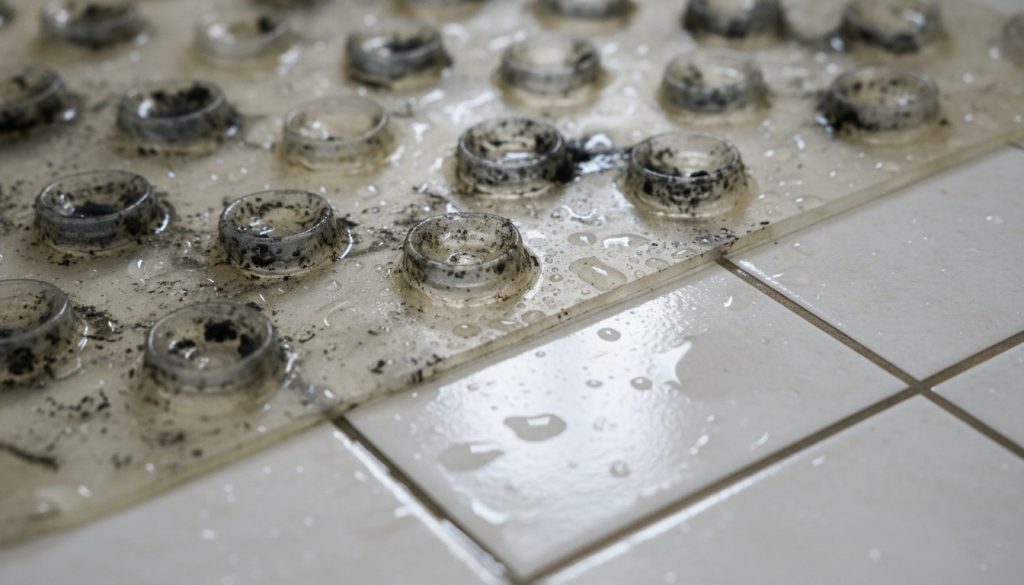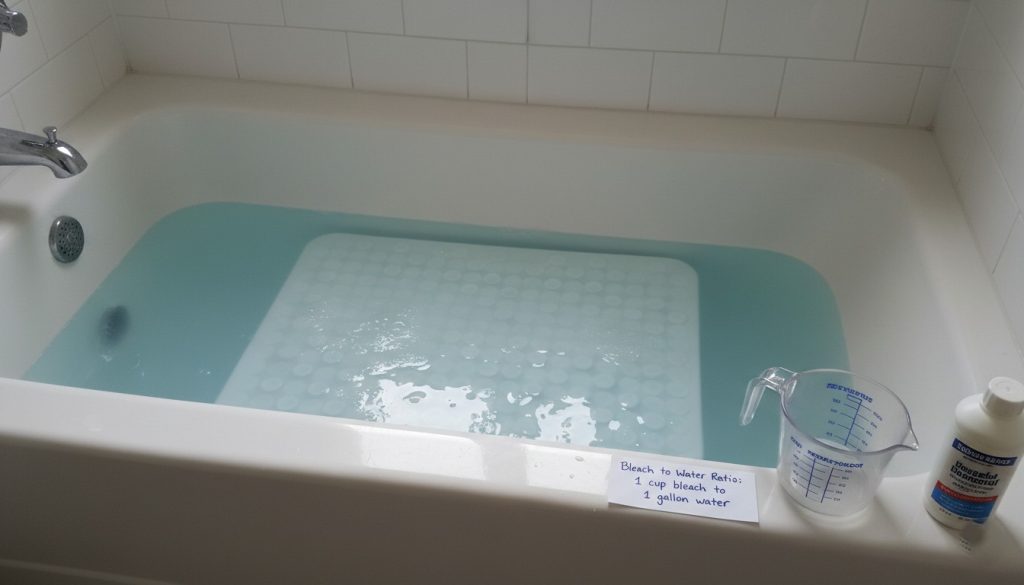I’ll be honest—when I first bought a plastic bath mat for my bathroom, I thought it would be maintenance-free. Just rinse it occasionally, right? Wrong. After a few weeks of regular use, I noticed dark spots forming underneath and a musty smell starting to develop. That’s when I realized I needed to learn the best way to clean a plastic bath mat before things got out of hand. Now, after years of dealing with bathroom mats, I’ve figured out what actually works.
If you’re struggling with how to clean bath mats or worried about mold and mildew taking over, you’re not alone. The good news? It’s easier than you might think, and I’m here to walk you through everything I’ve learned.
Why Plastic Bath Mats Need Regular Cleaning
Plastic bath mats are amazing for their grip and durability, but they create the perfect environment for moisture buildup. Every time you step out of the shower, water pools underneath your mat, creating a breeding ground for bacteria and mildew. Unlike fabric mats that dry relatively quickly, plastic mats trap moisture against your tile floor, which is why plastic bath mat cleaning needs to be part of your regular bathroom routine.
The real issue isn’t just about appearances. When mold and mildew develop under your mat, they can affect your bathroom’s air quality and potentially cause health issues, especially if anyone in your household has respiratory sensitivities. I learned this the hard way when my son started sneezing every time he used the bathroom. Once I got serious about bathroom mat cleaning tips, the problem disappeared.

Getting Started: Basic Supplies You’ll Need
Before diving into how to clean a plastic bath mat, gather these simple items. You probably have most of them already. I keep a small cleaning kit under my sink specifically for mat maintenance, and it saves me time whenever I’m ready to tackle the job.
You’ll want some white vinegar, which I’ve found is gentler than harsh chemicals but incredibly effective. Baking soda is another pantry staple that works wonders for deodorizing. If you prefer a stronger approach, bleach works well too—I’ll explain how to clean bath mat with bleach safely in a moment. A soft-bristled brush, some old towels, and a spray bottle complete your toolkit. That’s it. You don’t need expensive specialized products.
The Weekly Quick Clean: Maintaining Your Mat Between Deep Cleans
Here’s something I wish I’d known earlier: regular maintenance prevents major problems. Every week, I give my plastic bath mat a quick wash that takes maybe five minutes.
After my morning shower, I pick up the mat and lean it against the tub. Using the shower spray, I rinse both the top and underside thoroughly, making sure to get all the soap residue and hair out of the suction cups. Then I wipe it down with a towel and lean it against the wall to air dry completely before putting it back down. This simple routine has basically eliminated my mold problems.
The reason this works is that you’re removing the organic material (soap, hair, skin cells) that feeds mold growth. You’re also preventing water from sitting stagnant underneath the mat all week long. It’s preventative maintenance at its best.
Deep Cleaning: How to Clean a Plastic Bath Mat Thoroughly
When a quick rinse isn’t enough, it’s time for a deeper clean. I do this about once a month, and it keeps my mat looking and smelling fresh.
Using Vinegar and Baking Soda
Vinegar is my go-to for plastic bath mat cleaning because it’s effective against mildew without being toxic. I mix equal parts white vinegar and warm water in a spray bottle, then spray both sides of the mat generously. Let it sit for about 15 minutes—this gives the vinegar time to break down any buildup.
While it’s sitting, I sprinkle baking soda on the underside. The combination of vinegar and baking soda creates a fizzing action that lifts dirt and mold spores from the suction cups and textured surface. Using my soft-bristled brush, I scrub gently in circular motions, paying special attention to the nooks and crannies where moisture loves to hide.
After scrubbing, I rinse everything thoroughly under hot water. The mat smells noticeably fresher, and the discoloration usually fades significantly.
The Bleach Method: Best Way to Clean Plastic Bath Mat for Stubborn Mildew
If vinegar alone isn’t cutting it, bleach is your heavy hitter. I use this method maybe twice a year when I notice stubborn dark spots that won’t budge.

Mix one part bleach with ten parts water—this is crucial because straight bleach can damage the mat and harm your skin. I soak my mat in this solution for about 30 minutes. During this time, the bleach penetrates and kills the mold at its source. After soaking, I scrub with my brush, rinse thoroughly multiple times to remove all bleach residue, and then rinse again to be absolutely sure.
Important note: always ventilate well when using bleach. I open windows and turn on the exhaust fan. Never mix bleach with other cleaners—this creates dangerous fumes. I learned this lesson from a scary incident in college that I don’t care to repeat.
Dealing with Stubborn Mold and Mildew
If you’re already dealing with serious mold, don’t panic. Remove mold from bath mat situations are more common than you’d think, especially in humid climates. I live in an area with high humidity, so I’ve had my share of battles.
For bath mat mildew removal when things have gotten out of hand, I use a two-step approach. First, I do the bleach soak as described above. If any spots remain, I make a paste of baking soda and hydrogen peroxide (not bleach—never mix these), apply it directly to the affected areas, let it sit for a couple hours, then scrub and rinse.
The key is patience. Sometimes stubborn mildew needs multiple treatments over several weeks. I’ve noticed that once I solve the underlying moisture problem (proper drying between uses), the mildew doesn’t return even if I don’t bleach as frequently.
Non-Slip Bath Mat Maintenance: Preserving Your Mat’s Function
Here’s something I didn’t consider when I first started learning how to clean bath mats: aggressive cleaning can actually wear down the non-slip suction cups. When you’re maintaining your mat, you want to preserve that critical safety feature.
I avoid scrubbing the suction cup side with anything abrasive. Instead, I use softer brushes and focus on gentle circular motions. When cleaning, I make sure the suction cups aren’t clogged with debris, which prevents them from gripping properly anyway. Sometimes just a good rinse and a gentle brush-through keeps those cups functioning perfectly.
If your mat’s grip starts failing despite good maintenance, it’s probably time to replace it. I typically get 2-3 years out of a quality plastic mat with proper care, which feels like a good value.
Drying Bath Mats: The Often-Overlooked Step
This might sound obvious, but proper drying is absolutely essential for preventing future problems. I can’t stress this enough: how you dry your mat is just as important as how you clean it.

After cleaning or daily use, I stand my mat up against the wall at an angle so air can circulate underneath. I never lay it flat immediately because that just recreates the moisture-trapping situation. On sunny days, I sometimes lean it near a window where it gets direct sunlight—UV rays naturally kill mold spores and help it dry faster.
Some people suggest hanging their mats over the shower rod or towel bar. I’ve tried this, and it works well too. The key is elevating it so both the top and bottom get air exposure. I try to give my mat at least a few hours of air drying before putting it back down on the floor.
In winter or humid months when drying takes longer, I sometimes use a hair dryer on cool setting to speed things up, though this feels excessive. Usually, just positioning it properly is enough.
Extend Bath Mat Lifespan: Long-Term Care Strategies
Beyond just cleaning, there are things you can do to help extend bath mat lifespan and keep it functioning well for years.
First, I rotate my mat occasionally if I have more than one. This gives the suction cups a break and reduces wear patterns. Second, I store it properly when not in use for extended periods. Before putting it away, I make absolutely sure it’s completely dry, then I store it in a dry, ventilated area. Never stuff a damp mat into a cabinet or closet.
Third, I’m gentle with it. I don’t use high-pressure washers or bleach so strong it damages the material. And I replace it before it completely falls apart—waiting until the suction cups are completely shot means you’re increasing slip hazards.
Fourth, I’ve learned to address water pooling issues in my bathroom. If water consistently pools in certain areas, those spots will always cause problems. Sometimes the solution is as simple as tilting my mat slightly or using a second mat to absorb overflow.
My Honest Assessment: Is It Worth the Effort?
After all this experience with plastic bath mats, I still think they’re worth the maintenance. Compared to fabric mats that get heavy and hard to wash, or the safety concerns with worn rugs, plastic mats offer a good balance. The cleaning process isn’t difficult—it’s mostly just being consistent with quick rinses and doing a deeper clean monthly.
The investment of five minutes weekly and maybe 20 minutes monthly has basically eliminated bathroom mold and mildew for me. More importantly, it’s kept my family safe by maintaining good grip on what is, after all, a potentially slippery surface.
Final Thoughts on Bathroom Mat Cleaning Tips
Learning how to clean a plastic bath mat has genuinely improved my bathroom experience. What started as a frustrating problem—that musty smell and visible mold—became manageable once I understood the underlying issues: moisture accumulation and lack of circulation.
The best way to clean plastic bath mat really comes down to consistency. A little bit of maintenance regularly beats a massive cleaning project occasionally. Start with the weekly quick rinse, graduate to monthly deep cleans, and don’t hesitate to use bleach when you need it. Your future self—and your nose—will thank you.
Your bathroom deserves to feel fresh and safe, and honestly, keeping your plastic bath mat clean is one of the easiest wins you can have in your cleaning routine.
Leave a Reply